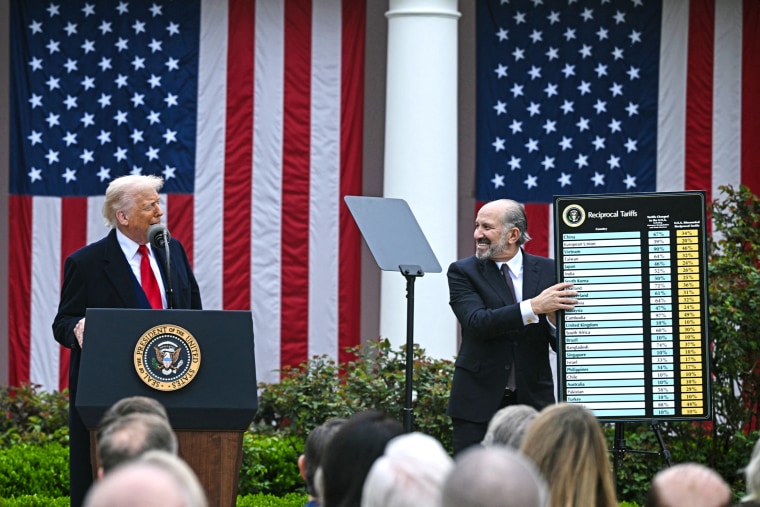Trump’s tariffs rollout beset by confusion, uncertainty and mixed messages
President Donald Trump on Wednesday officially fulfilled a campaign promise to unleash sweeping tariffs, a move that has sparked fears of a global trade war and prompted a major question about what has become the centerpiece of his economic agenda: What’s his endgame?
In both size and scope, Trump’s ultimate blueprint for global tariffs — a 10% baseline tariff on virtually every country, with higher numbers on countries with which the United States has larger trade deficits — was more than most expected. It has left global financial markets tumbling and Trump’s Republican supporters trying to thread the political needle of not criticizing him while also understanding the economic peril the tariff plan may usher in ahead of 2026 midterm elections in which the GOP will try to defend its slim House and Senate majorities.
Trump’s team has so far not had a clear message to either explain the strategy behind the tariffs that his political allies can echo or his thought process behind the decision to go much further than even supporters were expecting.
What’s more, multiple elements of the sweeping measures made it seem as if the administration rushed through the process — including its decision to levy tariffs on uninhabited islands and its initially listing tariff numbers on the White House list published Thursday that were different from the ones on the chart Trump held in the Rose Garden on Wednesday.

One day after the announcement, Trump was not helping provide any of that clarity, posting cryptic messages on Truth Social that the “patient lived,” an apparent reference to the U.S. economy, and that the “operation is over,” though the tariffs have yet to be imposed.
“THE OPERATION IS OVER! THE PATIENT LIVED, AND IS HEALING,” he posted on a day when the Dow Jones Industrial Average lost more than 1,600 points. “THE PROGNOSIS IS THAT THE PATIENT WILL BE FAR STRONGER, BIGGER, BETTER, AND MORE RESILIENT THAN EVER BEFORE.”
“MAKE AMERICA GREAT AGAIN!!!,” he added.
On Thursday afternoon, Trump doubled down on the analogy in defending his move to reporters who asked about the financial markets’ tanking one day after his tariff announcement.
“I think it’s going very well,” he said. “It was an operation like when a patient gets operated on.”
Trump at various points has framed the tariff plan as a revenue generator for the country, saying last week that the tariffs would raise “billions of dollars, even trillions of dollars, coming into our country.” At the same time, though, he has discussed them in terms of “fairness,” the idea that they could be used as a tool to rebalance the global economy, which, according to Trump, has been plagued by foreign nations’ taking advantage of the United States.
Trump has long viewed a trade deficit as a “subsidy” the United States provides another country. Economists have almost uniformly rejected that idea, pointing out that many countries are either too small or too poor to buy enough U.S. goods to offset their exports.
The sheer size of the tariff proposal and the lack of clear communication from the administration have left some Trump supporters skeptical and unsure what’s coming next.
“I have no idea,” a Trump supporter and 2024 donor said when asked what they thought Trump’s end goal was. “This is much larger than I think most thought would happen during the campaign. I guess the best case is he gets some concessions from countries quickly and pulls back. I don’t know.”
A senior Senate GOP aide said White House deputy chief of staff Stephen Miller spoke at a lunch with Senate chiefs of staff Thursday to address concerns. This person said Miller handled the tough questioning well and made strong points about the national security rationale behind reshoring critical supply chains, given the Covid crisis.
But this person said the White House has yet to offer effective messaging on other fronts related to the wide-ranging tariffs.
“They’ve got the broad, overarching theme down of what they’re trying to say with reorienting the economy,” this person said. “The difficult part of this is what do you say to the small business that says these tariffs are going to put me under. And I’ve yet to hear a compelling talking point on that.”
The tariffs give congressional Republicans even more urgency to pass tax cuts to alleviate some of the pressures of the tariffs, said this person, who believes Trump is “willing to make a deal” on the trade measures, though.
“Donald Trump views everything as a negotiation, right?” this person…
Read More: Trump’s tariffs rollout beset by confusion, uncertainty and mixed messages

